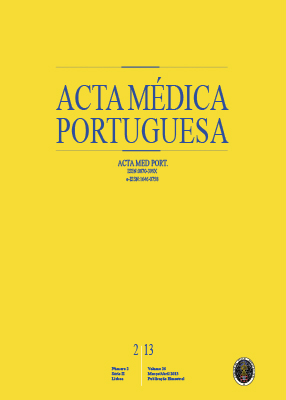Biomarkers of Cervical Carcinogenesis Associated with Genital Human Papillomavirus Infection
DOI:
https://doi.org/10.20344/amp.93Abstract
Introduction/Objective: Persistent infection with high-risk human papillomavirus (HPV) types is a necessary cause for cervical cancer development. The aim of this study was to evaluate the significance of different molecular markers for cervical carcinogenesis, and to assess their association with cervical intraepithelial neoplasia. Materials and Methods: 378 cervical samples from women attending to primary Health Clinics of the National Health Service and Gynaecological Outpatient Clinics and referred for HPV testing were analyzed between between January 2007 and December 2010. According to cytological diagnosis, five groups were defined: normal, ASCUS, LSIL, HSIL, and ICC. For the determination of viral DNA physical status was performed by using a real-time PCR methodology, over expression of E6/E7 mRNA NASBA amplification was performed with the NucliSENS EasyQ HPV assay and viral load was determined by a real-time PCR. HPV status was studied in relation to lesion severity. Statistical analysis was performed with SPSS software 16.0 and Chi-Square test. Results: No significant statistical differences were found between the physical status of HPV 16 or 18 and lesion severity. Overexpression of E6/E7 mRNA increased with lesion severity. Viral load was significantly associated with the development of cervical intraepithelial lesion. Conclusions: Data suggests that viral integration for HPV 16 seems to be an early event on cervical carcinogenesis, not being suitable as a molecular marker. E6/E7 mRNA and viral load can be more valuable approaches to use as biomarkers in the prevention of cervical cancer development.
Downloads
Downloads
Published
How to Cite
Issue
Section
License
All the articles published in the AMP are open access and comply with the requirements of funding agencies or academic institutions. The AMP is governed by the terms of the Creative Commons ‘Attribution – Non-Commercial Use - (CC-BY-NC)’ license, regarding the use by third parties.
It is the author’s responsibility to obtain approval for the reproduction of figures, tables, etc. from other publications.
Upon acceptance of an article for publication, the authors will be asked to complete the ICMJE “Copyright Liability and Copyright Sharing Statement “(http://www.actamedicaportuguesa.com/info/AMP-NormasPublicacao.pdf) and the “Declaration of Potential Conflicts of Interest” (http:// www.icmje.org/conflicts-of-interest). An e-mail will be sent to the corresponding author to acknowledge receipt of the manuscript.
After publication, the authors are authorised to make their articles available in repositories of their institutions of origin, as long as they always mention where they were published and according to the Creative Commons license.









